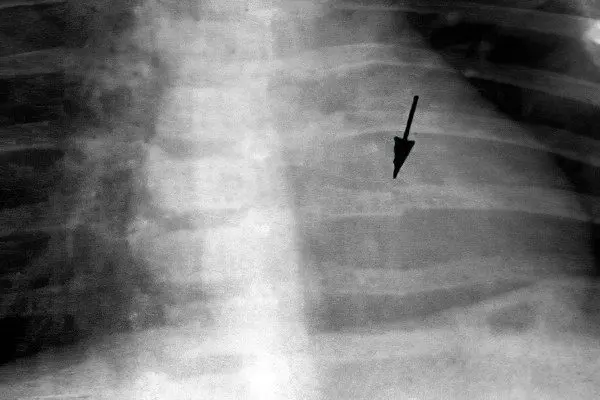Contents
The root cause of rib fractures is a directed blow, a fall from a height, or chest tightness. In many cases, a rib fracture occurs in the lateral part of the sternum. This is due to the fact that on the sides of the human body, the ribs have the greatest bend. If there is a fracture of one rib, then the displacement of the fragments is rarely observed. But a numerous fracture is often characterized by a dangerous displacement of fragments, the sharp ends of which can injure the lungs, intercostal vessels and pleura.
Symptoms of a displaced rib fracture

The main symptom of such an injury is a rather sharp pain in the chest. It becomes stronger when moving, talking, breathing, coughing, and weakens when sitting quietly. At the same time, the person’s breathing is shallow, in the affected area of the sternum there is a lag during breathing. During palpation, a broken rib responds with sharp pain, and sometimes even a crunch of bone fragments.
Particularly difficult to tolerate are lateral and anterior displaced rib fractures, in which breathing is significantly impaired. Damaged posterior ribs do not interfere with pulmonary ventilation as much as the anterior and lateral ones. Numerous fractures of the ribs with displacement significantly worsen the patient’s well-being. He has shallow breathing, rapid pulse, blanching of the skin with blue, general weakness. In the area of injury, bruises and noticeable swelling of the soft tissues are found. Injury to the lungs causes hemoptysis.
Dangerous consequences of fractures of the ribs with displacement
In the shortest possible time after the injury, complications such as hemothorax and pneumothorax are formed. After a few days, a complication of the condition with post-traumatic pneumonia is possible. This serious disease affects mainly elderly patients. A sign of a beginning pneumothorax is a change in the patient’s state of health for the worse, an increase in shortness of breath. Breathing is not audible in the area of the fracture.
Symptoms of incipient pneumonia are intoxication, shortness of breath, elevated body temperature, regression of the general well-being of the patient. It must be remembered that elderly patients and seriously ill patients do not always have a fever. There are times when only the general condition worsens. Post-traumatic pneumonia is manifested by a decrease in the level of ventilation of the lungs in the area of the fracture. Breathing is painful, shallow. Self-medication only complicates the condition of the victim.
Diagnosis and treatment of displaced rib fractures
The diagnosis of “fracture” and the complications following it are specified after a mandatory X-ray examination. If there is a suspicion of hemothorax and pneumothorax, then in addition, a pleural puncture, fluoroscopic examination and ultrasound are performed.
It is believed that in order for the ribs to grow together well, it is necessary to bandage the chest, thereby limiting its mobility. But this is fraught with congestion in the lungs, as a result of which post-traumatic pneumonia develops. In the majority of cases of rib fractures, fixation is not necessary, it is necessary only when there are numerous complicated fractures with displacement. And help should be provided only in the hospital. If you do not provide assistance in time, such injuries carry a direct danger to the life of the victim. To avoid this, at the slightest suspicion of a fracture of the ribs, a person should be sent to the hospital.
Fractures without complications of one or two ribs are treated on an outpatient basis. Victims with fractures of more than three ribs are sent to traumatology for hospitalization. Upon admission of a patient with an uncomplicated fracture of the ribs, the traumatologist does local anesthesia at the fracture site, after which he prescribes expectorants, analgesics, physiotherapy, and therapeutic breathing exercises to improve lung ventilation.
Elimination of complications
It happens that hemothorax and pneumothorax begin to progress some time after the patient arrives. In order to accurately identify the presence or absence of these conditions, additional fluoroscopy is performed. In case of complicated fractures of the ribs with displacement, additional medical measures are carried out in parallel with the above types of procedures.
A small amount of blood in the pleural cavity resolves itself. When a hemothorax is detected, a puncture of the pleural cavity is made (a specialist under local anesthesia with a special needle eliminates the accumulation of blood). Sometimes it is required to make a series of punctures with the repeated development of hemothorax.
With pneumothorax, it is sometimes enough to perform a puncture once to remove air. To do this, the incision area is anesthetized and a drainage tube is inserted. Air escapes through it, and the lungs straighten out. After this procedure, a control fluoroscopy is performed and the drainage is pulled out.
Rehabilitation after a displaced rib fracture
Special therapeutic exercises are especially important for the resumption of natural ventilation of the lungs after such injuries. On average, treatment of displaced rib fractures is carried out within one month. The duration of fusion in multiple and complicated fractures depends on the severity of complications and on the general health of the victim.









